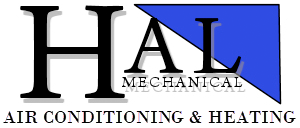The HVAC system that cools and heats the inside of the home is made of a number of different components. What each component plays is often a major role in heating or cooling the inside of the home. It is important to know each of the major components in order to properly troubleshoot your home’s HVAC system when problems occur. Hal Mechanical will share the primary components of the HVAC system and there role inside your system.
Thermostat
The thermostat is often considered the brains behind the heating and cooling system. The thermostat job is to constantly read the indoor air temperature inside the home. When the temperature fluctuates from the predetermined setting, it will activate the heating or cooling system. The thermostat is essential, yet it is also common for the thermostat to error out and be the source of a number of problems.
Furnace & Blower Motor
The furnace and blower motor are two major parts of the home heating system. The furnace is a large unit that most often is installed inside the attic and is fueled by electricity, gas, propane, or oil. The blower is attached to the furnace and is responsible for circulating the heated air through the ductwork and into the home. The blower motor can also pull the cool air out of the home through the return registers where the cool air can be reheated. When the blower fails often there is poor air flow from the ductwork and vents.
Heat Exchanger
Within the furnace is a major component called the heat exchanger. The heat exchangers are solely responsible for creating the heat that is then sent through the blower. One of the common and more dangerous problems that can occur with a heat exchanger is a crack. Heat exchangers can expand and cause a crack that releases carbon monoxide gas into the home. Heat exchangers demand yearly inspection and service to prevent this dangerous problem from occurring.
Evaporator Coils
The evaporator coil is part of the home’s cooling system. The evaporator coil can be a part of or separate from the furnace depending on the system. It looks much like a car’s radiator. The air conditioning refrigerant passes through the evaporator coils which creates the cool air that is sent through the home. The blower also pushes the cool air and runs all year long. Due to this continuous activity, many HVAC problems occur at the blower’s motor. Evaporator coils can also become damaged. However, it is more common for the evaporator coils to become dirty and need cleaning.
Condensing Unit & Refrigerant Line
The refrigerant line is responsible for sending the refrigerant back and forth to the evaporator coils and the condensing unit. The condensing unit is found outside either on the roof or on the ground near the home. The condensing unit helps to absorb the heat from inside the home and sends the refrigerant to create the needed cool air.
Ductwork & Vents
The ductwork is a tube or tunneling system that runs throughout the home. The warm or cool air travels through these systems to send the conditioned air to the different zones of the home. The vents or registers connect the ductwork to the wall or ceiling in the home. The return registers are the vents that the indoor air is sucked through and houses the air filters. Air vents may need cleaning or repair as they can develop leaks. It is also important to change the air filters often.
Residential & Commercial HVAC Services & More in Aliante, Anthem, Desert Shores, Eldorado, Enterprise, Green Valley Ranch, Henderson, Inspirada, Mountain’s Edge, North LV, Peccole Ranch, Paradise, Providence, Rhodes Ranch, Seven Hills, Silverado Ranch, Spring Valley, Summerlin, Sunrise Manor, The Lakes, Tuscany Village & Las Vegas Nevada
Knowing the primary components of the HVAC system can help you better troubleshoot problems as they occur. For quality HVAC services and more, contact Hal Mechanical today.






